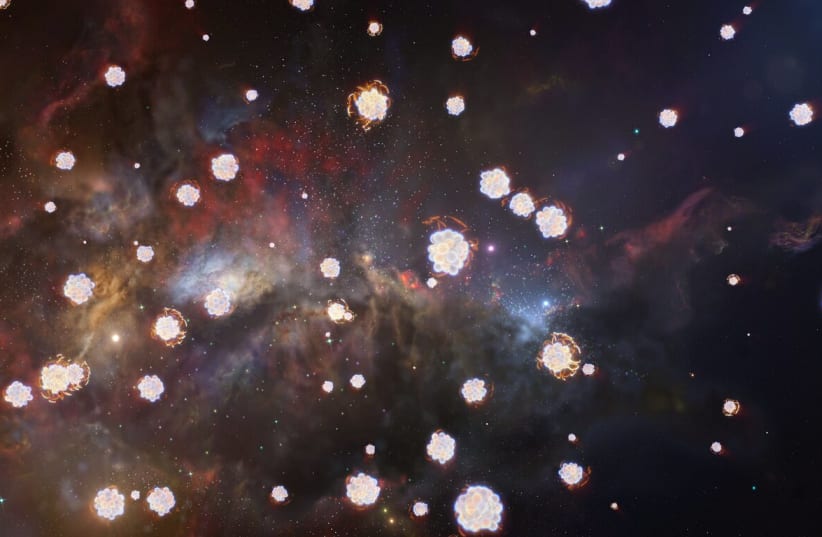Clouds of gas in the faraway reaches of space may house star remnants that could be some of the very first things ever created in the history of the universe, according to a new study.
The researchers at the European Southern Observatory (ESO) believe they may have found what remains of the first stellar explosions made after the Big Bang and the birth of existence as we know it.
The findings of this study were published in the peer-reviewed academic periodical The Astrophysical Journal.
When a star is born: Stellar formations and the birth of the universe
Stars are formed in molecular clouds, also known as stellar nurseries. These are typically dense condensations of gas and dust in regions of space, like in nebulae.
Here, some of the dust and gas will condense into itself through accretion before eventually becoming so massive that it undergoes gravitational collapse, due to the gas pressure no longer being able to support the mass and energy, thus forming a star.

This process is one that occurs throughout the universe, scattered about in different galaxies.
These stars are formed of a wide variety of different elements, mostly hydrogen and helium, but also some metals – a term used in astrophysics to refer to any element that is heavier than hydrogen and helium, the two lightest elements.
This makes sense considering the materials used to build the stars in the first place. All that scattered cosmic dust contains heavy metals formed by other stars and spread throughout the cosmos through a number of means, such as being propelled by supernovae.
How did those metals get there in the first place?
A basic law of physics is that matter can't be created or destroyed. However, it can be converted to other forms of matter.
The process by which a star does this is by using its heat, pressure and gravity over its extremely long lifespan in order to create nuclear fusion. Through this, it is able to transform hydrogen into helium and subsequently combine these elements together to create heavier ones.
This is a process known as nucleosynthesis and it is through this process that other elements are formed, with the heavier elements needing higher temperatures. Most of these only form towards the end of a star's life, as most of the time a star simply turns hydrogen into helium. Only towards the end of the lifespan of a star the size of our Sun would start fusing helium together, ultimately creating other, heavier elements. This lasts until it creates iron and nickel because anything heavier than that requires even more energy than the star can't provide. This leads to the star collapsing and, ultimately, exploding into a supernova – massive bursts of matter and energy, which is where elements heavier than iron and nickel are formed.
Consequently, later stars would also have more heavy metals, which would mean their supernovae would release even heavier ones.
This means that in the early days of the universe, there were no heavy metal elements in existence since stars hadn't yet formed to produce them.
But at the same time, the first stars in the universe have long been theorized to have been much purer in formation, being made exclusively of pristine gas with just hydrogen and helium until they too eventually exploded into supernovae, creating and spreading heavy elements that would eventually allow the expansion of the universe and to allow life to form.
Scientists have also theorized that these early stars would be far larger than the Sun, possibly hundreds of times more massive. These larger stars would also have been relatively short-lived before inevitably exploding into massive supernovae.
But studying this further was made difficult because we have yet to find any remnants of these early stars, until now.

Hunting down the universe's first stars
The ESO researchers made use of data obtained by the Very Large Telescope (VLT) in Chile. Here, they managed to identify three distant cosmic gas clouds that dated back several billions of years, when the universe was around a tenth of its current age.
This was done by following quasars, bright jets of light fueled by supermassive black holes in distant galaxies. This is because when light passes through something, it interacts with different elements differently. These imprints can be analyzed to help scientists figure out which elements did the light pass through.
The elements in these clouds seemed to resemble what scientists had long theorized was what the first supernovae would have released.
What they had figured is that the early elemental output of these first supernovae would have few heavier metals like iron but would contain lighter ones such as carbon and oxygen.
That is exactly what was detected in these clouds.
This chemical composition isn't anything new. In fact, there are many older stars in the Milky Way Galaxy that have similar compositions.
The older stars in the Milky Way are thought to be formed from even earlier stars, essentially being built off the ashes of those that came before.
But these clouds are so old that the earlier stars would likely have been the very first ones.
This discovery grants a peek at some of the very earliest days since the Big Bang.
In particular, it paves the way for further research as new and powerful telescopes and research tools are set to make their debuts and fill in the many blanks in our understanding of space.
It could also help address some other cosmic mysteries regarding the early days of the universe, such as the recent discovery of very large galaxies that existed just a few hundred million years after the – long before that should have been physically possible.
Only time will tell what further discoveries can be made by studying both our own cosmic neighborhood and some of the farthest reaches of space.
